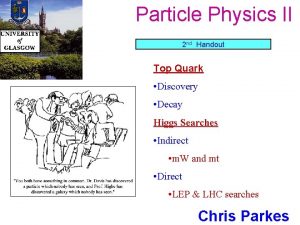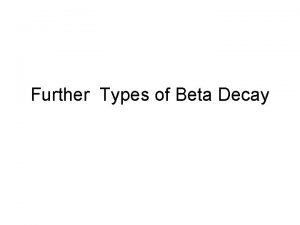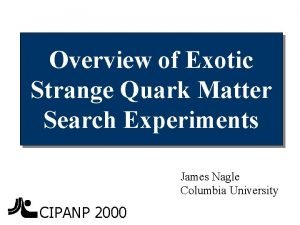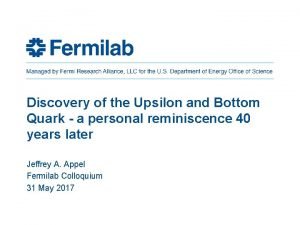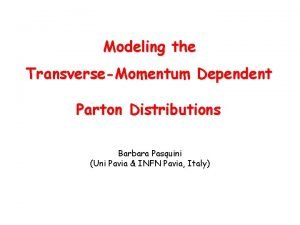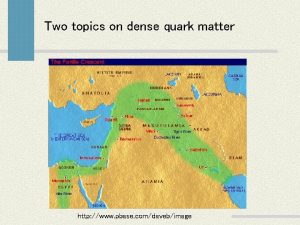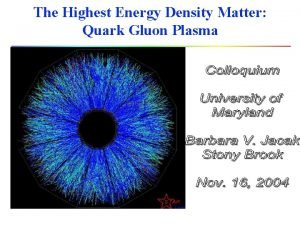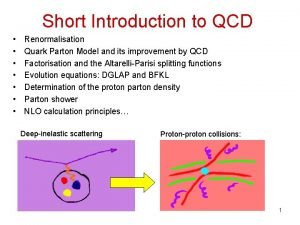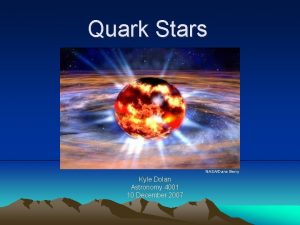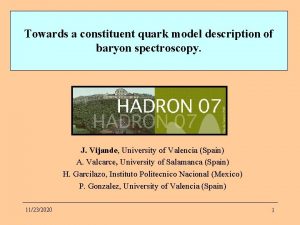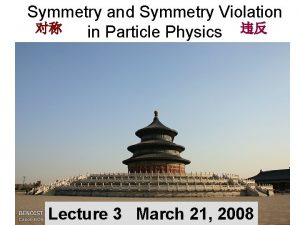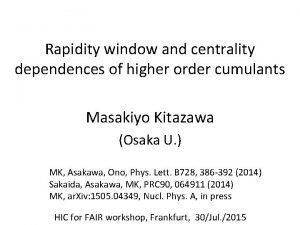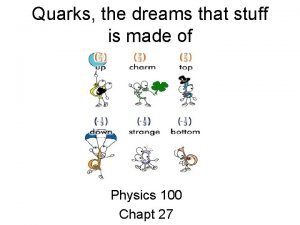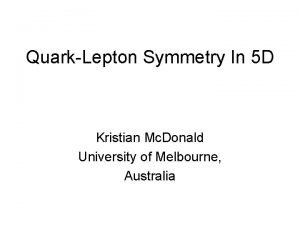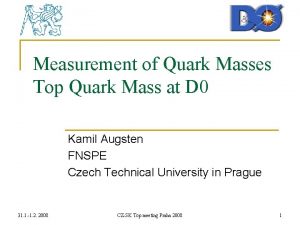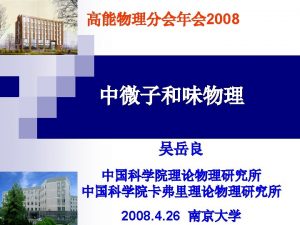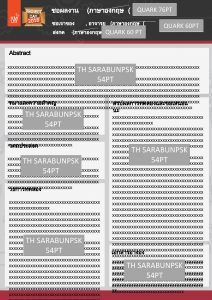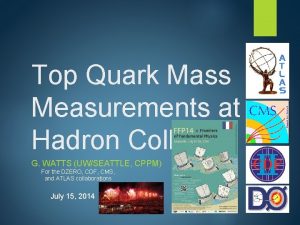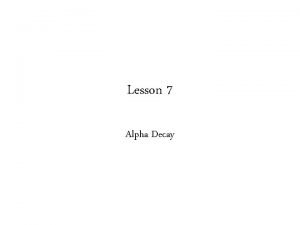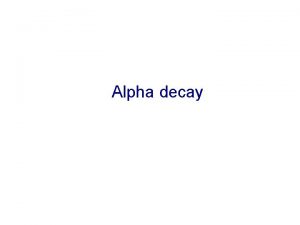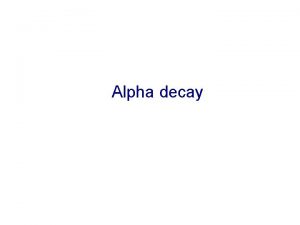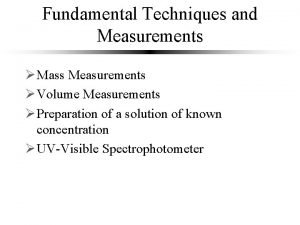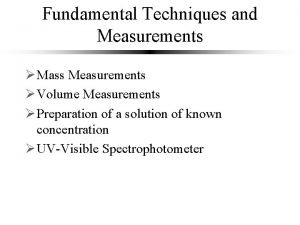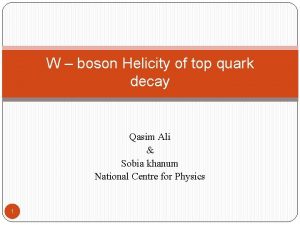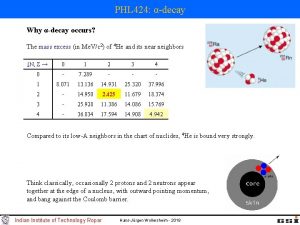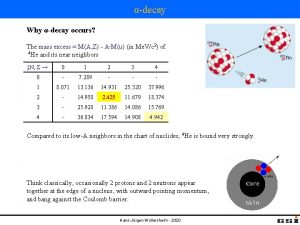Measurements of the top quark mass and decay


















- Slides: 18

Measurements of the top quark mass and decay width with the D 0 detector Yuriy Ilchenko on behalf of the D 0 collaboration Division of Particles and Fields of the American Physical Society Brown University 08/12/2011 1

Top quark in The Standard Model Top quark prominent facts: § Heaviest known elementary particle – about 175 Ge. V § § Fermions in The Standard Model short lifetime – τ t =(3. 3+1. 3 -0. 9) x 10 -25 s – decays before hadronizing Yukawa coupling to the Higgs boson is close to 1 (0. 996 ± 0. 0006) Prominent role : § Provides an indirect constraint on the Higgs mass and other particles through loop corrections § Can help in testing CPT invariance by measuring mtop- mantitop § Can be an indicator of New Physics Top quark is of particular importance for testing SM and searching for New Physics It is important to measure top quark properties precisely! 2

Measuring of top quark mass and width at D 0 § Mass § Matrix Element method § Neutrino Weighting method dilepton and lepton + jets channels § Mass difference (mtop- mantitop) § Matrix Element method § lepton + jets channel § § Width § Indirect measurement § single top t-channel cross section combined with measured branching ratio in double top production mode in single top production mode 3

tt production and decay § Production: double-top mode σ ≈ 7 pb @ 2 Te. V ~85% ~15% ATLAS and CMS: quark-antiquark annihilation -15%, gluon fusion 85% § Decay: in SM t→Wb almost 100%. Dilepton (WW → llvv), Lepton + jets (WW → lvqq) Dilepton Br ~ 5%, Low background e, μ ν b-jet Lepton + jets Br ~ 30%, Moderate background e, μ ν b-jet jet b-jet 4

Matrix Element Method § Probability to observe tt event with kinematic quantities x measured in the detector is given PDF for finding a parton in proton/antiproton § § Partonic x-sec Transfer function – probability for partonic state y to be measured as x • Determined from Monte Carlo, tuned to match resolutions observed in data Partonic x-sec – cross section calculated to LO 5

Matrix Element Method § Compute Psig for ttbar and similarly Pbkg background § Assign probability Pevt to each event A(x) – accounts for efficiencies and acceptance f – fraction of signal Psig, Pbkg – probabilities for the event to be signal or background § Combined likelihood function for N events § Top quark mass is extracted from likelihood fit § Perform ensemble tests to ensure the correct mass extraction and for method calibration 6

Lepton + jets mass measurement Integrated luminosity is 3. 6 Event selection: § § § fb-1 Lepton + jets event diagram Exactly 4 jets - leading pt >40 Ge. V, other p. T > 20 Ge. V , at least 1 identified b-jet Lepton p. T > 20 Ge. V Missing ET > 20 Ge. V (e+jets), 25 Ge. V (μ+jets) § Use ME method to find top quark mass § measure mtop and k. JES simultaneously § Dominant background is W + jets § 2 quarks are from W and form jets • can calibrate jet energy by constraining invariant mass to MW=80. 4 Ge. V W decays into 2 jets. Allows to additionally calibrate jets energy 7

Flavor dependent correction § § § Brings the simulation of jet response into agreement with Data • jets from different partons have different jet response Flavor dependent correction is based on Single Particle responses • correct b independently from light jets • b/light systematic has been significantly reduced → Data-MC jet response difference systematic Discrepancy in energy between Data and MC Ei, Ri – single particle energy and response § Define correction factor for jet of flavor β flavor-averaged in γ+jets events § Correct jet energies based on their flavor Systematical uncertainty is significantly reduced! (Fcorr-1) for light jets in |η|<1. 4 8

Lepton + jets results Top quark mass measurement in lepton + jets final states: mtop = 176. 0 ± 1. 0 (stat. ) ± 0. 8 (jes. ) ± 1. 0 (syst. ) Ge. V mtop = 176. 0 ± 1. 6 Ge. V , L = 3. 6 fb-1 D 0 most precise top quark single mass measurement • in-situ calibration • flavor dependent correction (k. JES = 1. 013 ± 0. 008) Fitted contours of equal probability 2 D likelihood in mtop and k. JES 9

Lepton + jets systematic uncertainties Largest systematic – Hadronization and UE § derived by comparing modeling hadronization and underlying events in PYTHIA and HERWIG. Being improved. Major systematic improvement -Data -MC jet response § reduces b/light systematic that was 0. 83 Ge. V 10

Dilepton mass measurement Integrated luminosity is 5. 4 fb-1 Event selection: § § § Dilepton event diagram Exactly 2 oppositely charged, isolated leptons p. T > 15 Ge. V At least 2 jets – |η|<2. 5, leading pt >20 Ge. V Additional topological cuts against Z+jets background § Use ME method to find top quark mass § Dominant background is Z + jets Mass measurement result: Full kinematic reconstruction is impossible. One degree of freedom is missing. mtop = 174. 01 ± 1. 8 (stat. ) ± 2. 4 (syst. ) Ge. V 11

Dilepton systematic uncertainties Largest systematics – b/light jet response and JES § jes cannot be constrained by W mass as in lepton + jets case § flavor dependent correction is not used here 12

D 0 mass combination § Results in different channels are in agreement § World average mtop is known better than 1% for the first time Combined mass measurement for D 0 and Tevatron Combined D 0 lepton + jets and dilepton result from Run I and Run II mtop = 175. 1 ± 0. 8 (stat. ) ± 1. 3 (syst. ) Ge. V or mtop = 175. 1 ± 1. 5 (stat. + syst. ) Ge. V D 0 top quark mass relative uncertainty is 0. 84% 13

Top quark mass difference § Top quark mass measurements assume mtop= mantitop § Mass difference would mean violation of CPT invariance § Top quark decays before hadronization → allows to measure directly quark-antiquark mass difference Is mtop= mantitop actually? § Integrated luminosity is 3. 6 fb-1 § Based on ME method in lepton + jets channel § measure mtop and manti-top directly and independently § two dimensional likelihood becomes L (mtop , JES) → L (mtop , mantitop) 14

Mass difference result Systematic uncertainties § Combined result for mass difference Δm: Δm = 0. 8 ± 1. 8 (stat. ) ± 0. 5 (syst. ) Ge. V § Agrees with no mass difference at the level of ≈ 1% Major additional systematic uncertainty – asymmetry in response to quark antiquark Fitted contours of equal probability in 2 D likelihood 15

Top quark width § Direct measurement – less sensitive § determines the width Γt from top quark mass spectrum § Γt < 7. 6 Ge. V (95% C. L. , L=4. 5 fb-1) by CDF collaboration § Indirect measurement – more precise § extracts width from single top t-channel cross-section measurement and branching fraction from ttbar Single top production diagram § assumes coupling is the same for production and decay 16

Top quark width results Derive the width using Bayesian statistical approach Result for top quark width and lifetime: Γt > 1. 21 Ge. V at 95% C. L. τ t =(3. 3+1. 3 -0. 9) x 10 -25 s L = 2. 3 fb-1 The width result is consistent with SM prediction Γt. SM = 1. 26 Ge. V (mtop = 170 Ge. V) New physics – can set a limit on high mass 4 th generation b’ quark • |Vtb’| < 0. 63 at 95% C. L. Partial width probability density distribution (expected and observed) 17

Conclusion § Mass difference for top-antitop – no CPT violation evidence § Indirect width measurement gives more sensitive result than direct measurement but somewhat model dependent (SM) § Mass measurement (combined result) – less than 1% error mtop = 175. 1 ± 0. 8 (stat. ) ± 1. 3 (syst. ) Ge. V mtop = 175. 1 ± 1. 5 (stat. + syst. ) Ge. V 18
 Top quark decay
Top quark decay Exponential decay factor
Exponential decay factor Beta decay
Beta decay Quark physics wordle
Quark physics wordle Quarks
Quarks Quark names
Quark names Quark model
Quark model Quark gluon plasma
Quark gluon plasma Quark gluon
Quark gluon Quark parton model
Quark parton model Quark astronomy
Quark astronomy Quark gluon plasma
Quark gluon plasma Quark names
Quark names Constituent quark model
Constituent quark model A charm quark has a charge of approximately
A charm quark has a charge of approximately Zamjena za quark sir
Zamjena za quark sir Quark gluon plasma
Quark gluon plasma Quark types
Quark types Quark lepton symmetry
Quark lepton symmetry
